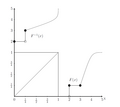Inverse transform sampling
Inverse Transform Sampling (ITS), also known as the inverse probability integral transform, is a fundamental method in the field of statistics and probability theory for generating sample numbers at random from any probability distribution, given its cumulative distribution function (CDF). This technique is widely used in simulation and Monte Carlo methods, where it allows for the transformation of uniformly distributed random numbers into numbers distributed according to a desired distribution.
Overview
The principle behind inverse transform sampling is based on the properties of the cumulative distribution function. For a given continuous random variable X with a probability density function (PDF) f(x) and a cumulative distribution function F(x), the CDF is defined as:
- F(x) = P(X \leq x) = \int_{-\infty}^{x} f(t) dt
The CDF F(x) is a non-decreasing function that ranges from 0 to 1. The inverse transform sampling method exploits the fact that if U is a uniform random variable on the interval [0, 1], then the variable X defined as F^(-1)(U) has the same distribution as the original variable with CDF F(x).
Procedure
The steps involved in inverse transform sampling are as follows:
- Generate a random number u from the uniform distribution over the interval [0, 1].
- Compute the inverse of the cumulative distribution function, F^(-1)(u).
- The value obtained in step 2 is a random number that follows the desired distribution.
Applications
Inverse transform sampling is utilized in various fields such as computer science, engineering, and finance, where simulations involving random variables are required. It is particularly useful in cases where direct sampling from the desired distribution is complex or infeasible.
Limitations
While inverse transform sampling is a powerful tool, it has limitations. The method requires the inverse of the CDF to be known or easily computable, which is not always the case. For distributions where the inverse CDF is difficult to obtain, alternative methods such as rejection sampling, Markov chain Monte Carlo methods, or piecewise linear approximation may be more appropriate.
See Also
- Monte Carlo method
- Probability distribution
- Cumulative distribution function
- Rejection sampling
- Markov chain Monte Carlo
References
This article is a statistics-related stub. You can help WikiMD by expanding it!
Transform your life with W8MD's budget GLP-1 injections from $125.
W8MD offers a medical weight loss program to lose weight in Philadelphia. Our physician-supervised medical weight loss provides:
- Most insurances accepted or discounted self-pay rates. We will obtain insurance prior authorizations if needed.
- Generic GLP1 weight loss injections from $125 for the starting dose.
- Also offer prescription weight loss medications including Phentermine, Qsymia, Diethylpropion, Contrave etc.
NYC weight loss doctor appointments
Start your NYC weight loss journey today at our NYC medical weight loss and Philadelphia medical weight loss clinics.
- Call 718-946-5500 to lose weight in NYC or for medical weight loss in Philadelphia 215-676-2334.
- Tags:NYC medical weight loss, Philadelphia lose weight Zepbound NYC, Budget GLP1 weight loss injections, Wegovy Philadelphia, Wegovy NYC, Philadelphia medical weight loss, Brookly weight loss and Wegovy NYC
|
WikiMD's Wellness Encyclopedia |
| Let Food Be Thy Medicine Medicine Thy Food - Hippocrates |
Medical Disclaimer: WikiMD is not a substitute for professional medical advice. The information on WikiMD is provided as an information resource only, may be incorrect, outdated or misleading, and is not to be used or relied on for any diagnostic or treatment purposes. Please consult your health care provider before making any healthcare decisions or for guidance about a specific medical condition. WikiMD expressly disclaims responsibility, and shall have no liability, for any damages, loss, injury, or liability whatsoever suffered as a result of your reliance on the information contained in this site. By visiting this site you agree to the foregoing terms and conditions, which may from time to time be changed or supplemented by WikiMD. If you do not agree to the foregoing terms and conditions, you should not enter or use this site. See full disclaimer.
Credits:Most images are courtesy of Wikimedia commons, and templates, categories Wikipedia, licensed under CC BY SA or similar.
Contributors: Prab R. Tumpati, MD





